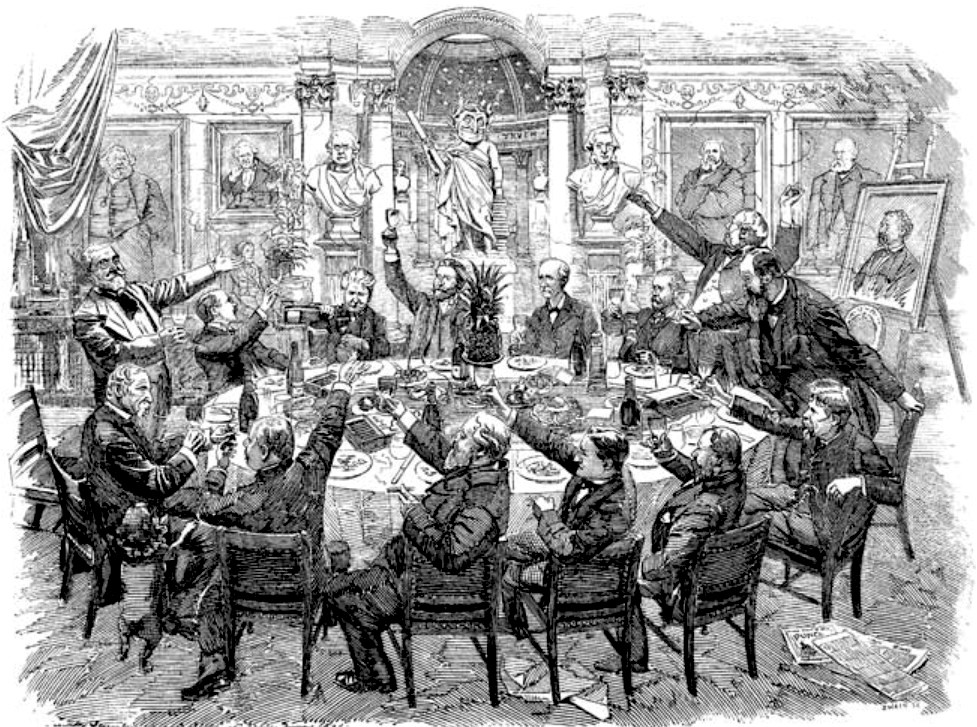
This cartoon by Linley Sambourne, entitled "The Mahogany Tree" (referring of course to the wooden table) marked the jubilee of Punch in 1891, with both present and former members of staff gathered round or overlooking the table at the magazine's offices in Bouverie Street, off Fleet Street. Note the pineapple in pride of place in the middle of the table, symbol of luxury and hospitality. Cigar boxes are open all around the table, too, for a convivial after-dinner smoke. Indeed, some of the participants can be seen with cigar in hand.
Sambourne was delighted to be summoned to The Table in 1871 and attended regularly for the rest of his working life. A general consultation took place over the Wednesday dinner about the contents of next week's edition, with much good-natured argument and exchange of views. Contributions from the cartoonists had to be submitted by Friday evening so that the engraver, Joseph Swain, could set to work. Proofs were sent out on a Monday and the magazine was published a few days later.
During the 1880s there was a gradual change in printing techniques and Zincography, known as Process, was substituted for wood block. Drawings could now be done on paper and thus preserved for subsequent private sale. This pleased Sambourne very much but Sir John Tenniel insisted on keeping to the old method, so Swain's name can still be seen on his cartoons long after the younger cartoonists had dropped him. ("Process" has confused many later writers: even art historian Marion Spielmann mis-described it in his History of Punch - he did not understand it either!).
Sambourne set about the drawing with his usual thoroughness. He put a large table and some chairs in his own back yard at Stafford Terrace and photographed the setting from the rear window of his drawing room on the first floor. He then summoned each participant in turn for a portrait photo in his chosen attitude. (These photos are in the Sambourne archive.)
Key to Sambourne's Cartoon
Rodney Engen identifies those present as (clockwise from left): Francis Cowley Burnand (1836-1917, editor of the magazine from 1880–1906, standing up); Thomas Anstey Guthrie (1856–1934, parodist); Henry Lucy (1842-1924, parliamentary sketch writer), Edward Tennyson Reed (1860–1933, political cartoonist after Harry Furniss, see below), Gilbert à Beckett (1837-1891, parodist); E.J. Millikin (d. 1897, editor 1877-1897, and creator of 'Arry); Sir William Agnew (1825-1910, the art dealer, also chairman of Punch's publishers, Bradbury, Agnew & Co., from 1890); Agnew's publishing partner William Bradbury, half-standing (1830-1892), George Du Maurier with his hand on the chair-arm; Harry Furniss; Rudolph Chambers Lehmann (1856–1929, parodist); Arthur à Beckett (1844-1909, a staff member like his brother Gilbert); Sambourne himself; Mr Punch's dog Toby, with his paws on the back of the chair; and Tenniel, with his luxuriant white drooping moustaches (see Engen 48 for the order of appearance).
The portraits on the wall, and some of the busts, are of those associated with the magazine who had now passed away. Most are harder to identify. Again, Engen provides a list, comprising: Mark Lemon (1809-1870, founding editor); Gilbert à Beckett (father of Gilbert and Arthur, who are sitting at the table); Douglas Jerrold; William Makepeace Thackeray, whose bust is easily recognisable and situated immediately left of the figure of Mr Punch himself); Richard Doyle; Thomas Hood; John Leech; Shirley Brooks; and Tom Taylor. Finally, Engen identifies the portrait on the easel behind Bradbury as that of Charles Keene (again, see p. 48).
Note: Links, dates and other details have been added by Jacqueline Banerjee. Such details are not given here if they are easily found via the links.
Links to Related Material
- Punch, or the London Charivari (1841-1992) — A British Institution
- Punch, or the London Charivari (sitemap)
Bibliography
Engen, Rodney. Sir John Tenniel: Alice's White Knight. Aldershot: Scolar Press, 1991. See pp. 48 and 49.
Created 22 February 2024